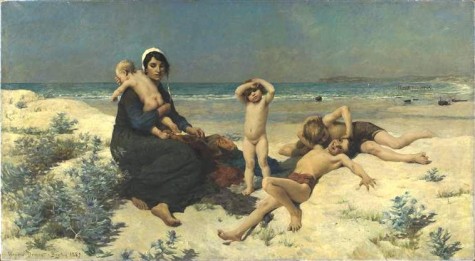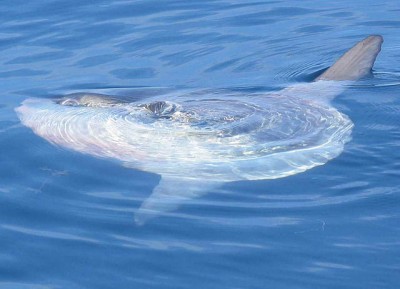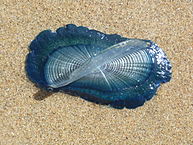 Right now the ocean is glorious. In the evenings, even if the day hasn’t been too hot, you can throw yourself into the saltwater and float between the waves for a while without your teeth chattering.
Right now the ocean is glorious. In the evenings, even if the day hasn’t been too hot, you can throw yourself into the saltwater and float between the waves for a while without your teeth chattering.
This is not normal. Even in summer (at least for me), any extended taking of the waters requires a wetsuit, if not the full 4 millimeters of ankle-to-wrist neoprene that’s needed in winter, at least some layer of protection. But we’ve got an unusual warm spell that was cast over the upper layers of the nearshore waters in the first part of July.
Here’s what happened: some local winds have fizzled, and the upwelling—the cold water that surges up from the lower reaches, full of nutrients that kickstart phytoplankton blooms and then draw lots of creatures that feed on them—slowed down, shifting warmer water toward the beaches. A fair amount warmer: water temperatures in July were as much as seven degrees Fahrenheit higher than normal.
 All this warm water has brought unusual species toward the beaches, especially south of the Golden Gate Bridge. Not just bathers wearing—shockingly—bathing suits, but ocean sunfish, which laze on the ocean’s surface to bask. If the warm water sticks around, more temperate species like yellowtail or bluefin tuna could move closer to shore, but cold-water species, including the already-struggling salmon, might suffer.
All this warm water has brought unusual species toward the beaches, especially south of the Golden Gate Bridge. Not just bathers wearing—shockingly—bathing suits, but ocean sunfish, which laze on the ocean’s surface to bask. If the warm water sticks around, more temperate species like yellowtail or bluefin tuna could move closer to shore, but cold-water species, including the already-struggling salmon, might suffer.
The waters have also been teeming with by-the-wind sailors (Velella velella), jellyfish-like creatures that have been hovering offshore in flotillas so large that some thought there’d been an oil spill. They’re now freckling the beaches in August, if freckles could be blue and translucent. It’s not quite clear why they’ve shown up this year in such force, but those seeing these or other surprising sea creatures can report the sighting to jellywatch.org.
Some think the warmer water is a sign of a coming El Niño—a strong version of this warm-ocean phenomenon is often linked to more rainfall in California. But the National Weather Services and associated groups just downgraded the likelihood of an El Niño to 65 percent, as the water surface temperatures out farther in the Pacific aren’t much different than usual. If one does come, it will probably be weak, and may not make a dent in our drought.
In the morning and in the evening, fishing boats hover several hundred yards off the bluff, their lights trained on the water. It’s not the usual gathering—around dawn, I can often hear the buzz of their motors as they go out to the Channel Islands. But now they’re waiting to net squid, which are running thick, much closer to shore than usual.
I’ll be closer to shore than usual, too. I’ll float on the surface like a sunfish, and hope for rain.
**
Images
Demont-Breton-la-plage by Virginie Demont-Breton; Poissonlune mole3; Velella velella by Notafly — all via Wikimedia Commons